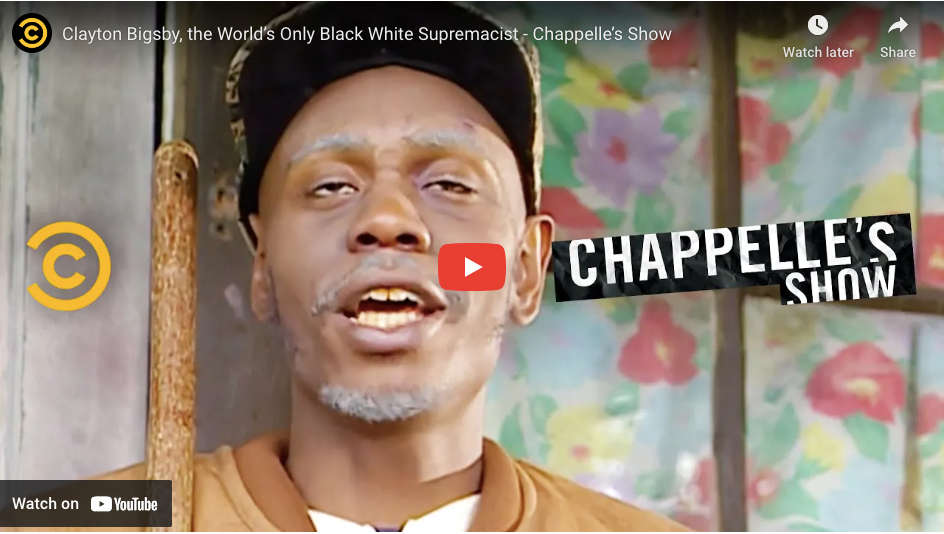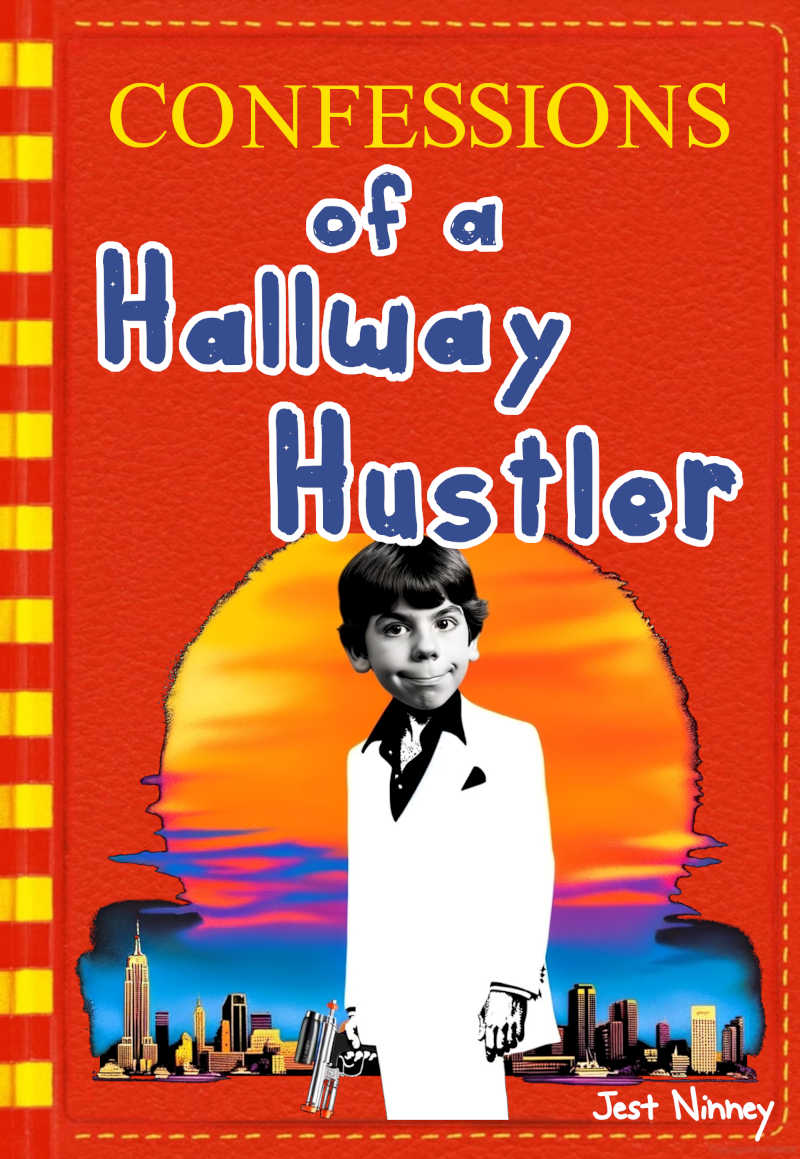Introduction
Dave Chappelle is widely celebrated for his unique blend of incisive humor and daring thematic exploration. Known for pushing boundaries and addressing complex social issues with a comedic touch, Chappelle has established himself as a master of satire and parody. His ability to weave laughter with serious commentary has earned him a place among the most influential comedians of our time.
One of the most striking examples of his use of parody is found in the sketch “Frontline: Clayton Bigsby” from the “Chappelle’s Show” (2003, Season 1, Episode 1). This sketch presents a paradoxical and humorous scenario: Clayton Bigsby, a blind African American man who, is unaware of his own race. He becomes an ardent member and leader of the Ku Klux Klan. The sketch uses this absurd premise to create a satirical narrative that not only evokes laughter but also critically examines the absurdities and irrationalities of racism.
Background of the sketch
- “Chappelle’s Show,” which first aired in 2003, stood out for its raw and candid humor. Dave Chappelle, the show’s creator and star, used the platform to push boundaries and provoke thought, often addressing topics like race, culture, and American society.
- Chappelle’s comedic style was marked by its fearlessness and willingness to confront uncomfortable truths. He often employed parody and satire as tools to highlight and critique societal issues, especially those related to race and identity.
- The sketch “Frontline: Clayton Bigsby” epitomized this approach. It presented a unique blend of absurdity and sharp social commentary, using the format of a mockumentary to tell its story.
Analyzing the Parody in “Clayton Bigsby”
Concept and Execution
The Premise
The core concept of the sketch is a stark and absurd juxtaposition: a Black man who vehemently supports and espouses white supremacist ideologies. The character of Clayton Bigsby is blind since birth, and this lack of awareness about his own race is what fuels the sketch’s central irony. Bigsby grows up in an orphanage in a predominantly white area and is led to believe he is white. His blindness is a metaphor for ignorance, and it serves to amplify the absurdity of racial prejudice.
The Documentary Style
Mimicking Documentary Conventions
- The sketch opens with the familiar conventions of a documentary: a serious tone, a voiceover narrator, and introductory shots that set the scene. This style immediately sets a tone of authenticity and gravity, which contrasts sharply with the absurdity of the subject matter.
Use of Voiceover
- The voiceover, typically associated with serious and factual programming, lends an air of legitimacy and authority to the story. This contrast between the serious presentation and the ridiculous content creates a comedic dissonance that is central to the sketch’s humor.
Enhancing the Satirical Impact
Building Credibility
- By framing the story as a documentary, the sketch initially invites the audience to suspend disbelief and engage with the narrative as they would with a factual account. This engagement makes the subsequent reveal – that the protagonist, Clayton Bigsby, is a blind Black man who is unaware of his own race – even more jarring and absurd.
Critiquing Media and Perception
- The documentary style also serves as a subtle critique of media presentation. It suggests that the authoritative voice of media can often lend credence to even the most absurd or hateful ideas, highlighting the power and responsibility of how stories are told and framed.
Role of Visuals and Editing
Visual Irony
- The visuals play a crucial role in the parody, juxtaposing images of traditional white supremacist iconography with the central character, who is Black. This visual irony is heightened by the serious, documentary-style presentation.
Editing for Emphasis
- The editing mimics that of a documentary, with cuts to interviews, archival footage, and images that would typically be used to support factual reporting. This approach further embeds the sketch within the documentary genre, making the absurdity of the situation more pronounced.
In “Frontline: Clayton Bigsby,” Chappelle employs a classic sketch structure with a clear premise, gradual escalation, and a surprise twist at the end, all of which are fundamental components of effective comedic storytelling. This structure not only enhances the humor but also sharpens the sketch’s satirical edge.
Setup
The sketch begins by setting a clear and provocative premise: Clayton Bigsby, a blind African American man, is an ardent white supremacist, unaware of his own race. The premise is as absurd as it is shocking, immediately capturing the audience’s attention. This initial setup is crucial as it lays the foundation for the parody, allowing Chappelle to explore the ridiculousness of racism and bigotry through an extreme yet humorous lens.
Gradual Escalation
As the sketch progresses, the absurdity escalates. The audience is shown Bigsby’s life, his beliefs, and his activities within the white supremacist community. Chappelle gradually heightens the comedic and satirical elements through exaggerated scenarios and dialogues. This escalation serves a dual purpose: it amplifies the humor while also intensifying the sketch’s commentary on the irrational nature of prejudice. The sketch effectively uses exaggeration to mirror and mock real-life bigotry, making the point that racism can be as blind as Bigsby himself.
Surprise Ending
The climax of the sketch features a surprise: when Bigsby’s true identity as a Black man is revealed to his white supremacist followers. This moment of revelation is crafted for maximum comedic effect, as it completely upends the expectations set up by the initial premise. The twist not only serves as a punchline to the sketch but also reinforces its underlying message. It highlights the absurdity and ignorance inherent in racist ideology, showing that hatred can be so blind that it fails to recognize its own contradictions.
Exaggeration of Klan Members
One of the most striking elements of parody in this sketch is the way Dave Chappelle exaggerates the characteristics and behaviors of the Ku Klux Klan members. The members are depicted as absurdly ignorant and blindly hateful, to the point of irrationality. This exaggeration serves to mock the real-life absurdities and contradictions within racist ideologies. By amplifying these traits to a ridiculous extent, Chappelle highlights the inherent folly and ignorance in racist thinking and behavior.
Satire on Racism and Ignorance
The sketch employs satire to address the serious issues of racism and ignorance. Through the character of Clayton Bigsby, Chappelle presents a biting commentary on the arbitrary and constructed nature of racial identities and prejudices. The absurdity of Bigsby’s situation — being a celebrated figure within the Klan while being the very thing they stand against — serves as a metaphor for the illogical and self-contradictory nature of racism.
Contrast Between Beliefs and Identity
Perhaps the most compelling aspect of the parody is the stark contrast between Clayton Bigsby’s beliefs and his true identity. As a blind black man who has been led to believe he is white, Bigsby embodies a profound irony. His vehement racism against his own race serves to underscore the ridiculousness and often baseless foundations of prejudiced beliefs. This contrast is not only humorous but also serves as a poignant critique of the arbitrary nature of racial hatred. It forces the audience to confront the absurdity of judging individuals based on race and challenges the viewer to reflect on the deep-seated prejudices that can exist in society.
Themes in “Clayton Bigsby”
The Absurdity of Racism
At its core, the sketch portrays racism as inherently absurd. Clayton Bigsby, a blind African American man who is unaware of his own race, fervently espouses racist beliefs and is an active member of the Ku Klux Klan. This premise alone turns the concept of racism on its head, illustrating its irrational nature. The idea that someone could unknowingly hate their own race is a powerful commentary on the baseless and nonsensical foundations of racist ideologies. Chappelle’s portrayal of Bigsby highlights the ridiculousness of judging individuals based on race, a social construct that has no bearing on a person’s character or abilities.
Blind Hatred and Ignorance
The theme of “blind hatred” is literal and metaphorical in the sketch. Bigsby’s blindness serves as a metaphor for the willful ignorance that often accompanies prejudice. His inability to see his own skin color represents how bigots often overlook the humanity and reality of those they irrationally despise. This blindness extends to the sketch’s portrayal of other characters, who are oblivious to the absurdity of a Black man leading the Klan. This reflects a broader societal commentary on how racism can persist not only through active malice but also through ignorance and denial.
Parody as Social Commentary
Chappelle masterfully uses parody as a tool for social commentary. By exaggerating and satirizing real-world attitudes and situations, he invites viewers to reconsider their perspectives on race and racism. The sketch does not just aim to entertain; it challenges its audience to confront uncomfortable truths about prejudice and hatred in society. Through humor, Chappelle breaks down barriers, making it possible to discuss serious and often taboo subjects in a more approachable way.
Impact and Reception of “Clayton Bigsby”
Audience Reaction at Release
When “Clayton Bigsby” first aired, it immediately garnered widespread attention and sparked a mix of reactions. Viewers were both shocked and amused by the audacity of the sketch’s premise—a blind Black man who, unaware of his own race, becomes a vehement white supremacist. The sketch’s absurdity, coupled with Chappelle’s skillful delivery, led to a notable reaction:
- Shock and Humor: The sketch was seen as groundbreaking for its bold approach to race, using extreme parody to highlight the irrational nature of racism. Many viewers appreciated the sketch for its daring humor and the way it tackled taboos in a manner not commonly seen on television.
- Controversy: Some viewers and critics found the sketch controversial, questioning whether it was appropriate to use such sensitive racial topics as material for comedy.
Lasting Impact on Discussions About Race and Comedy
Over time, “Clayton Bigsby” has become more than just a memorable sketch; it has sparked deeper discussions about race, comedy, and the boundaries of satire:
- Dialogue on Racism: The sketch has been used as a reference point in discussions about the absurdity and constructed nature of racial biases. By pushing the boundaries of what is acceptable in comedy, Chappelle forced audiences to confront uncomfortable truths about racism.
- Influence on Comedians and Writers: Chappelle’s approach influenced other comedians and writers to explore sensitive social and political topics through parody. It showed that comedy could be used not just to entertain, but to provoke thought and discussion.
- Academic Analysis: The sketch has been the subject of academic analysis, with scholars examining its impact on cultural perceptions of race and the role of parody in social commentary.
- Changing Perceptions of Comedy: The sketch contributed to a broader understanding of how comedy can be a powerful tool for addressing and dissecting societal issues. It challenged the notion that certain topics are off-limits for humor, suggesting that the way such topics are approached is key.
Further Study
Acham, Christine. “‘I’m Rich, Bitch!!!’: The Comedy of Chappelle’s Show.” Cable Visions: Television Beyond Broadcasting, edited by Sarah Banet-Weiser et al., NYU Press, 2007, pp. 319–37. JSTOR, http://www.jstor.org/stable/j.ctt9qg15n.22. Accessed 15 Jan. 2024.
Carpenter, Faedra Chatard. Coloring Whiteness: Acts of Critique in Black Performance. University of Michigan Press, 2014. Project MUSE muse.jhu.edu/book/36841.
Dunbar, Jessie LaFrance. “Teaching Satirical Literacy and Social Responsibility through Race Comedy.” MELUS: Multi-Ethnic Literature of the U.S., vol. 42 no. 4, 2017, p. 79-91. Project MUSE muse.jhu.edu/article/680703.
Gillota, David. “‘JUST US’: African American Humor in Multiethnic America.” Ethnic Humor in Multiethnic America, Rutgers University Press, 2013, pp. 20–47. JSTOR, http://www.jstor.org/stable/j.ctt5hjctg.5. Accessed 15 Jan. 2024.
Haggins, Bambi. Laughing Mad: The Black Comic Persona in Post-Soul America. Rutgers University Press, 2007. Project MUSE muse.jhu.edu/book/6104.


